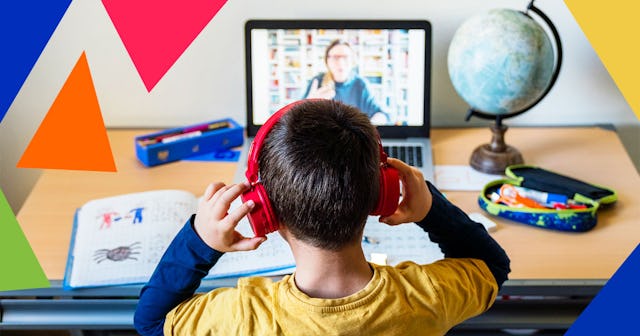E-Learning Has Gotten Some Major Upgrades For This School Year––Let's Talk About It

Face it: we all know that last spring’s COVID-19 forced foray into virtual learning was unplanned, slapdash, and not what any of us expected. They’re doing something brand-new: teaching nearly an entire nation of children virtually. They’re scared. They’re worried. But there’s a lot of cool virtual teaching that’s going to happen this fall. Teachers have new ideas of what they can use in the classroom, and they are working tirelessly behind the scenes to maximize your child’s virtual learning experiences.
I talked to my husband, a high school teacher, about what he and his colleagues are doing, and it sounds really cool.
How Is Virtual Learning Going to Be Different?
It’s not in-person instruction, but teachers have found programs to help them make e-learning engaging and fun.
The keystone to a good virtual experience is good software. Last Spring, most teachers were sticking to Zoom, or whatever their district asked them to use. This time, they’ve done their research, and software companies have realized the classroom potential of their programs… and beefed them up. So this year, parents will see that virtual learning uses different software to accomplish many of the tasks students do in a traditional classroom. Teachers have had to get creative, for example, about how to ask questions and generate responses from every student. And they’ve found ways to do it.
The key is to have some patience and grace as they roll this out, and help their students acclimate to this new learning environment. They are one person virtually teaching an entire classroom of kids—and sometimes teaching kids in-person and virtually at the same time. There will be some bumps along the way as everyone finds their groove.
Virtual Learning Is About Visuals
One of the greatest assets of a physical classroom is the way that it looks — the inviting colors, the artwork, the shared achievements and cooperative work environment. Replicating that in a virtual classroom is difficult, but clever teachers are going to make your child’s virtual learning experience as vivid as possible. Programs like Padlet allow students and teachers to create engaging, interactive flowcharts, graphic organizers, and posters that pop with color and possibilities. Instead of getting a stuffy lecture, the student can be introduced to concepts with engaging infographics, and compose responses in a dynamic, multimedia format.
10’000 Hours/Getty
Microsoft has spruced up PowerPoint with Pear Deck, an add-on that turns the mind-numbing slideshows we all dread into something different: an interactive experience that allows students to click links, answer questions, or add their own content to work collaboratively with their peers. Instead of just staring at a boring slideshow, they’ll be active participants in creating content alongside their teachers and fellow classmates. Other programs that your kids will be familiar with already, like Kahoot, Quizlet, and Flocabulary, have upped their game and made their interfaces more colorful, engaging, and (gasp) even fun.
Virtual Learning Connects Students And Teachers
Ask parents, students, and teachers what they miss the most about in-person learning, and they’ll all invariably give the same answer: the relationships and community that develops in a classroom. All of us can name our favorite teachers, or who we sat next to in second grade; the social aspect of schooling is one of its most important aspects, and the part that was hit the hardest when we all isolated in the springtime.
While no form of virtual learning is going to replace that, there is a silver lining. Teachers will be using programs that take the best parts of social media to make your child’s virtual learning experience as personal and face-to-face as possible. Programs like Flipgrid take the scrolling feed of micro-length videos that has made TikTok your kid’s favorite (and possibly most baffling) app and turned that into the virtual learner’s best friend. For attendance, quick quizzes, or even just a roll call of good mornings, students will be able to record little videos so that they can see and hear their classmates and teachers, and turn your little burgeoning exhibitionists into engaged participants in class. If it convinced an entire generation that flossing was a good dance, then the least it can do is help make them learn.
The Virtual Classroom Has Improved
Many of you are still going to be regularly using Zoom too, of course. You’ve already had to weather The Great Zoom Crash.
But for some of you, your little scholar will be connecting via Google Classroom or Microsoft Teams, and by now your kid’s teacher has worked hard to familiarize themselves with whatever format they will be using. They’ll be able to mute microphones at will to get rid of echoes, or turn off cameras if that one kid (you know which one) in the kindergarten class decides it’s pants-off dance-off time. They can instantly break the class into smaller videochat groups to work together. There’s no danger of people, pets, infants dropping in on class. Long live Google Classroom and MS Teams.
Your kid’s teacher is learning. Everything won’t be perfect. Remember: they’ve never done this before. There’ll be snags along the way. There’ll be a kid juuling on Microsoft Classroom. Some little kid will Flipgrid a pants-off dance-off. Software, hardware, internet connections, and electricity in general will go bonkers at times. But they’re doing their best to give your kid a virtual learning experience they can, if not love, at least learn from.